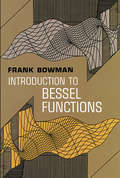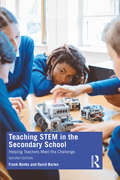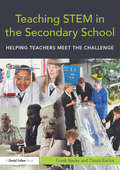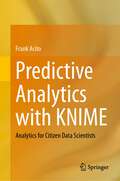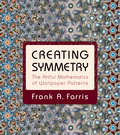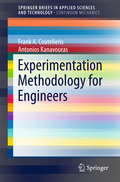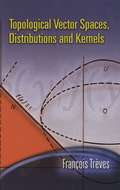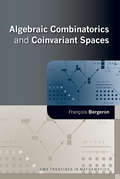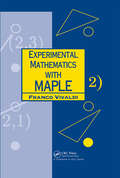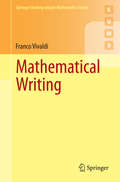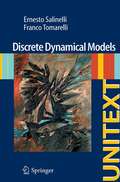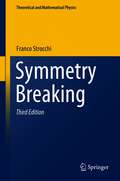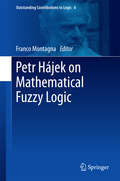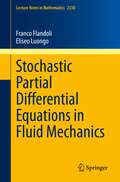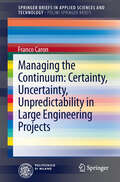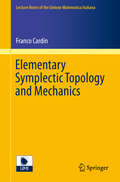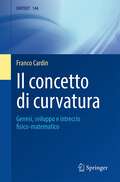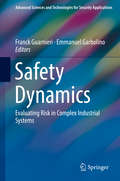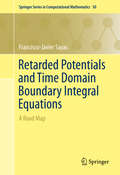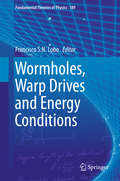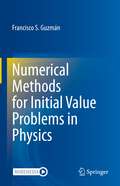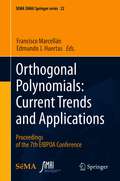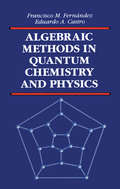- Table View
- List View
Introduction to Bessel Functions (Dover Books on Mathematics)
by Frank BowmanA full, clear introduction to the properties and applications of Bessel functions, this self-contained text is equally useful for the classroom or for independent study. Topics include Bessel functions of zero order, modified Bessel functions, definite integrals, asymptotic expansions, and Bessel functions of any real order. More than 200 problems throughout.
Applied Probability and Stochastic Processes
by Frank BeicheltApplied Probability and Stochastic Processes, Second Edition presents a self-contained introduction to elementary probability theory and stochastic processes with a special emphasis on their applications in science, engineering, finance, computer science, and operations research. It covers the theoretical foundations for modeling time-dependent random phenomena in these areas and illustrates applications through the analysis of numerous practical examples. The author draws on his 50 years of experience in the field to give your students a better understanding of probability theory and stochastic processes and enable them to use stochastic modeling in their work. New to the Second Edition Completely rewritten part on probability theory—now more than double in size New sections on time series analysis, random walks, branching processes, and spectral analysis of stationary stochastic processes Comprehensive numerical discussions of examples, which replace the more theoretically challenging sections Additional examples, exercises, and figures Presenting the material in a student-friendly, application-oriented manner, this non-measure theoretic text only assumes a mathematical maturity that applied science students acquire during their undergraduate studies in mathematics. Many exercises allow students to assess their understanding of the topics. In addition, the book occasionally describes connections between probabilistic concepts and corresponding statistical approaches to facilitate comprehension. Some important proofs and challenging examples and exercises are also included for more theoretically interested readers.
Teaching STEM in the Secondary School: Helping Teachers Meet The Challenge
by David Barlex Frank BanksThis book looks at the purpose and pedagogy of STEM teaching and explores the ways in which STEM subjects can interact in the curriculum to enhance student understanding, achievement and motivation. By reaching outside their own classroom, teachers can collaborate across STEM subjects to enrich learning and help students relate school science, technology and maths to the wider world. Packed with ideas and practical details for teachers of STEM subjects, the new revised edition of this book: ■ considers what the STEM subjects contribute separately to the curriculum and how they relate to each other in the wider education of secondary school students; ■ describes and evaluates different curriculum models for STEM; ■ suggests ways in which a critical approach to the pedagogy of the classroom, laboratory and workshop can support and encourage all pupils to engage fully in STEM; ■ addresses the practicalities of introducing, organising and sustaining STEM-related activities in the secondary school; ■ looks to ways schools can manage and sustain STEM approaches in the long-term. This new revised edition is essential reading for trainee and practising teachers, those engaged in further professional development and all who wish to make the learning of science, technology, engineering and mathematics an interesting, motivating and exciting experience for their students.
Teaching STEM in the Secondary School: Helping teachers meet the challenge
by David Barlex Frank BanksThe skills, knowledge and understanding of the subjects involved in STEM (Science, Technology, Engineering and Mathematics) are vital for all young people in an increasingly science- and technology-driven society. This book looks at the purpose and pedagogy of STEM teaching and explores the ways in which STEM subjects can interact in the curriculum to enhance student understanding, achievement and motivation. By reaching outside their own classroom, teachers can collaborate across subjects to enrich learning and help students relate school science, technology and maths to the wider world. Packed with ideas and practical details for teachers of STEM subjects, this book: considers what the STEM subjects contribute separately to the curriculum and how they relate to each other in the wider education of secondary school students describes and evaluates different curriculum models for STEM suggests ways in which a critical approach to the pedagogy of the classroom, laboratory and workshop can support STEM for all students addresses the practicalities of introducing, organising and sustaining STEM-related activities in the secondary school looks to ways schools can manage and sustain STEM approaches in the long-term. This timely new text is essential reading for trainee and practising teachers who wish to make the learning of Science, Technology, Engineering and Mathematics an interesting, motivating and exciting experience for their students.
Predictive Analytics with KNIME: Analytics for Citizen Data Scientists
by Frank AcitoThis book is about data analytics, including problem definition, data preparation, and data analysis. A variety of techniques (e.g., regression, logistic regression, cluster analysis, neural nets, decision trees, and others) are covered with conceptual background as well as demonstrations of KNIME using each tool. The book uses KNIME, which is a comprehensive, open-source software tool for analytics that does not require coding but instead uses an intuitive drag-and-drop workflow to create a network of connected nodes on an interactive canvas. KNIME workflows provide graphic representations of each step taken in analyses, making the analyses self-documenting. The graphical documentation makes it easy to reproduce analyses, as well as to communicate methods and results to others. Integration with R is also available in KNIME, and several examples using R nodes in a KNIME workflow are demonstrated for special functions and tools not explicitly included in KNIME.
Creating Symmetry
by Frank A. FarrisThis lavishly illustrated book provides a hands-on, step-by-step introduction to the intriguing mathematics of symmetry. Instead of breaking up patterns into blocks--a sort of potato-stamp method--Frank Farris offers a completely new waveform approach that enables you to create an endless variety of rosettes, friezes, and wallpaper patterns: dazzling art images where the beauty of nature meets the precision of mathematics.Featuring more than 100 stunning color illustrations and requiring only a modest background in math, Creating Symmetry begins by addressing the enigma of a simple curve, whose curious symmetry seems unexplained by its formula. Farris describes how complex numbers unlock the mystery, and how they lead to the next steps on an engaging path to constructing waveforms. He explains how to devise waveforms for each of the 17 possible wallpaper types, and then guides you through a host of other fascinating topics in symmetry, such as color-reversing patterns, three-color patterns, polyhedral symmetry, and hyperbolic symmetry. Along the way, Farris demonstrates how to marry waveforms with photographic images to construct beautiful symmetry patterns as he gradually familiarizes you with more advanced mathematics, including group theory, functional analysis, and partial differential equations. As you progress through the book, you'll learn how to create breathtaking art images of your own.Fun, accessible, and challenging, Creating Symmetry features numerous examples and exercises throughout, as well as engaging discussions of the history behind the mathematics presented in the book.
Experimentation Methodology for Engineers (SpringerBriefs in Applied Sciences and Technology)
by Frank A. Coutelieris Antonios KanavourasThis book delivers a methodological approach on the experimentation and/or simulation processes from the disclaiming hypothesis on a physical phenomenon to the validation of the results. The main benefit of the book is that it discusses all the topics related to experimentation and validation of the outcome including state-of-the-art applications and presents important theoretical, mathematical and experimental developments, providing a self-contained major reference that is appealing to both the scientists and the engineers. At the same time, these topics are encountered in a variety of scientific and engineering disciplines. As a first step, it presents the theoretical and practical implications on the formation of a hypothesis, considering the existing knowledge collection, classification and validation of the particular areas of experimenting interest. Afterwards, the transition from the knowledge classes to the experimentation parameters according to the phenomena evolution contributors and the systemic properties of the descriptors are discussed. The major experimenting requirements focus on the conditions to satisfy a potential disclaim of the initial hypothesis as conditions. Furthermore, the experimentation outcome, as derived via the previous experimentation process set-up, would be validate for the similarities among the existing knowledge and derived new one. The whole methodology offers a powerful tool towards the minimization of research effort wastes, as far as it can identify the lacks of knowledge, thus the areas of interest where the current research has to work on. The special features of this book are (a) the use of state-of-the-art techniques for the classification of knowledge, (b) the consideration of a realistic systemic world of engineering approached phenomena, (c) the application of advanced mathematical techniques for identifying, describing and testing the similarities in the research results and conclusions, and (d) the experimental investigation of relevant phenomena.
Basic Linear Partial Differential Equations
by Francois TrevesFocusing on the archetypes of linear partial differential equations, this text for upper-level undergraduates and graduate students features most of the basic classical results. The methods, however, are decidedly nontraditional: in practically every instance, they tend toward a high level of abstraction. This approach recalls classical material to contemporary analysts in a language they can understand, as well as exploiting the field's wealth of examples as an introduction to modern theories.The four-part treatment covers the basic examples of linear partial differential equations and their fundamental solutions; the Cauchy problem; boundary value problems; and mixed problems and evolution equations. Nearly 400 exercises appear throughout the text, several containing detailed information that enables readers to reconstruct the proofs.
Topological Vector Spaces, Distributions and Kernels: Pure And Applied Mathematics (Dover Books on Mathematics #Volume 25)
by Francois TrevesThis text for upper-level undergraduates and graduate students focuses on key notions and results in functional analysis. Extending beyond the boundaries of Hilbert and Banach space theory, it explores aspects of analysis relevant to the solution of partial differential equations.The three-part treatment begins with topological vector spaces and spaces of functions, progressing to duality and spaces of distribution, and concluding with tensor products and kernels. The archetypes of linear partial differential equations (Laplace's, the wave, and the heat equations) and the traditional problems (Dirichlet's and Cauchy's) are this volume's main focus. Most of the basic classical results appear here. There are 390 exercises, several of which contain detailed information that will enable readers to reconstruct the proofs of some important results.
Algebraic Combinatorics and Coinvariant Spaces
by Francois BergeronWritten for graduate students in mathematics or non-specialist mathematicians who wish to learn the basics about some of the most important current research in the field, this book provides an intensive, yet accessible, introduction to the subject of algebraic combinatorics. After recalling basic notions of combinatorics, representation theory, and
Experimental Mathematics with Maple (Chapman Hall/CRC Mathematics Series)
by Franco VivaldiAs discrete mathematics rapidly becomes a required element of undergraduate mathematics programs, algebraic software systems replace compiled languages and are now most often the computational tool of choice. Newcomers to university level mathematics, therefore, must not only grasp the fundamentals of discrete mathematics, they must also learn to use an algebraic manipulator and develop skills in abstract reasoning.Experimental Mathematics with MAPLE uniquely responds to these needs. Following an emerging trend in research, it places abstraction and axiomatization at the end of a learning process that begins with computer experimentation. It introduces the foundations of discrete mathematics and, assuming no previous knowledge of computing, gradually develops basic computational skills using the latest version of the powerful MAPLE® software. The author's approach is to expose readers to a large number of concrete computational examples and encourage them to isolate the general from the particular, to synthesize computational results, formulate conjectures, and attempt rigorous proofs. Using this approach, Experimental Mathematics with MAPLE enables readers to build a foundation in discrete mathematics, gain valuable experience with algebraic computing, and develop a familiarity with basic abstract concepts, notation, and jargon. Its engaging style, numerous exercises and examples, and Internet posting of selected solutions and MAPLE worksheets make this text ideal for use both in the classroom and for self-study.
Mathematical Writing
by Franco VivaldiThis book teaches the art of writing mathematics, an essential -and difficult- skill for any mathematics student. The book begins with an informal introduction on basic writing principles and a review of the essential dictionary for mathematics. Writing techniques are developed gradually, from the small to the large: words, phrases, sentences, paragraphs, to end with short compositions. These may represent the introduction of a concept, the abstract of a presentation or the proof of a theorem. Along the way the student will learn how to establish a coherent notation, mix words and symbols effectively, write neat formulae, and structure a definition. Some elements of logic and all common methods of proofs are featured, including various versions of induction and existence proofs. The book concludes with advice on specific aspects of thesis writing (choosing of a title, composing an abstract, compiling a bibliography) illustrated by large number of real-life examples. Many exercises are included; over 150 of them have complete solutions, to facilitate self-study. Mathematical Writing will be of interest to all mathematics students who want to raise the quality of their coursework, reports, exams, and dissertations.
Discrete Dynamical Models
by Ernesto Salinelli Franco TomarelliThis book provides an introduction to the analysis of discrete dynamical systems. The content is presented by an unitary approach that blends the perspective of mathematical modeling together with the ones of several discipline as Mathematical Analysis, Linear Algebra, Numerical Analysis, Systems Theory and Probability. After a preliminary discussion of several models, the main tools for the study of linear and non-linear scalar dynamical systems are presented, paying particular attention to the stability analysis. Linear difference equations are studied in detail and an elementary introduction of Z and Discrete Fourier Transform is presented. A whole chapter is devoted to the study of bifurcations and chaotic dynamics. One-step vector-valued dynamical systems are the subject of three chapters, where the reader can find the applications to positive systems, Markov chains, networks and search engines. The book is addressed mainly to students in Mathematics, Engineering, Physics, Chemistry, Biology and Economics. The exposition is self-contained: some appendices present prerequisites, algorithms and suggestions for computer simulations. The analysis of several examples is enriched by the proposition of many related exercises of increasing difficulty; in the last chapter the detailed solution is given for most of them.
Symmetry Breaking: A Non-perturbative Outlook (Theoretical and Mathematical Physics #732)
by Franco StrocchiThe third edition of the by now classic reference on rigorous analysis of symmetry breaking in both classical and quantum field theories adds new topics of relevance, in particular the effect of dynamical Coulomb delocalization, by which boundary conditions give rise to volume effects and to energy/mass gap in the Goldstone spectrum (plasmon spectrum, Anderson superconductivity, Higgs phenomenon). The book closes with a discussion of the physical meaning of global and local gauge symmetries and their breaking, with attention to the effect of gauge group topology in QCD. From the reviews of the first edition: It is remarkable to see how much material can actually be presented in a rigorous way (incidentally, many of the results presented are due to Strocchi himself), yet this is largely ignored, the original heuristic derivations being, as a rule, more popular. - At each step he strongly emphasizes the physical meaning and motivation of the various notions introduced [...] a book that fills a conspicuous gap in the literature, and does it rather well. It could also be a good basis for a graduate course in mathematical physics. J.-P. Antoine, Physicalia 28/2, 2006 Despite many accounts in popular textbooks and a widespread belief, the phenomenon is rather subtle, requires an infinite set of degrees of freedom and an advanced mathematical setting of the system under investigation. [...] The mathematically oriented graduate student will certainly benefit from this thorough, rigorous and detailed investigation. G. Roepstorff, Zentralblatt MATH, Vol. 1075, 2006 From the reviews of the second edition: This second edition of Strocchi’s Symmetry Breaking presents a complete, generalized and highly rigorous discussion of the subject, based on a formal analysis of conditions necessary for the mechanism of spontaneous symmetry breaking to occur in classical systems, as well as in quantum systems. […] This book is specifically recommended for mathematical physicists interested in a deeper and rigorous understanding of the subject, and it should be mandatory for researchers studying the mechanism of spontaneous symmetry breaking. S. Hajjawi, Mathematical Reviews, 2008
Petr Hájek on Mathematical Fuzzy Logic
by Franco MontagnaThis volume celebrates the work of Petr Hájek on mathematical fuzzy logic and presents how his efforts have influenced prominent logicians who are continuing his work. The book opens with a discussion on Hájek's contribution to mathematical fuzzy logic and with a scientific biography of him, progresses to include two articles with a foundation flavour, that demonstrate some important aspects of Hájek's production, namely, a paper on the development of fuzzy sets and another paper on some fuzzy versions of set theory and arithmetic. Articles in the volume also focus on the treatment of vagueness, building connections between Hájek's favorite fuzzy logic and linguistic models of vagueness. Other articles introduce alternative notions of consequence relation, namely, the preservation of truth degrees, which is discussed in a general context, and the differential semantics. For the latter, a surprisingly strong standard completeness theorem is proved. Another contribution also looks at two principles valid in classical logic and characterize the three main t-norm logics in terms of these principles. Other articles, with an algebraic flavour, offer a summary of the applications of lattice ordered-groups to many-valued logic and to quantum logic, as well as an investigation of prelinearity in varieties of pointed lattice ordered algebras that satisfy a weak form of distributivity and have a very weak implication. The last part of the volume contains an article on possibilistic modal logics defined over MTL chains, a topic that Hájek discussed in his celebrated work, Metamathematics of Fuzzy Logic, and another one where the authors, besides offering unexpected premises such as proposing to call Hájek's basic fuzzy logic HL, instead of BL, propose a very weak system, called SL as a candidate for the role of the really basic fuzzy logic. The paper also provides a generalization of the prelinearity axiom, which was investigated by Hájek in the context of fuzzy logic.
Stochastic Partial Differential Equations in Fluid Mechanics (Lecture Notes in Mathematics #2328)
by Franco Flandoli Eliseo LuongoThis book is devoted to stochastic Navier–Stokes equations and more generally to stochasticity in fluid mechanics. The two opening chapters describe basic material about the existence and uniqueness of solutions: first in the case of additive noise treated pathwise and then in the case of state-dependent noise. The main mathematical techniques of these two chapters are known and given in detail for using the book as a reference for advanced courses. By contrast, the third and fourth chapters describe new material that has been developed in very recent years or in works now in preparation. The new material deals with transport-type noise, its origin, and its consequences on dissipation and well-posedness properties. Finally, the last chapter is devoted to the physical intuition behind the stochastic modeling presented in the book, giving great attention to the question of the origin of noise in connection with small-scale turbulence, its mathematical form, and its consequences on large-scale properties of a fluid.
Managing the Continuum: Certainty, Uncertainty, Unpredictability in Large Engineering Projects
by Franco CaronThe brief will describe how to develop a risk analysis applied to a project , through a sequence of steps: risk management planning, risk identification, risk classification, risk assessment, risk quantification, risk response planning, risk monitoring and control, process close out and lessons learning. The project risk analysis and management process will be applied to large engineering projects, in particular related to the oil and gas industry. The brief will address the overall range of possible events affecting the project moving from certainty (project issues) through uncertainty (project risks) to unpredictability (unforeseeable events), considering both negative and positive events. Some quantitative techniques (simulation, event tree, Bayesian inference, etc.) will be used to develop risk quantification. The brief addresses a typical subject in the area of project management, with reference to large engineering projects concerning the realization of large plants and infrastructures. These projects are characterized by a high level of change, uncertainty, complexity and ambiguity. The brief represents an extension of the material developed for the course Project Risk Analysis and Management of the Master in Strategic Project Management (Erasmus Mundus) developed jointly by Politecnico di Milano, Heriot Watt University (Edimburgh) and Umea (Sweden). The brief may be used both in courses addressing project management subjects and by practitioners as a guide for developing an effective project risk management plan.
Elementary Symplectic Topology and Mechanics
by Franco CardinThis is a short tract on the essentials of differential and symplectic geometry together with a basic introduction to several applications of this rich framework: analytical mechanics, the calculus of variations, conjugate points & Morse index, and other physical topics. A central feature is the systematic utilization of Lagrangian submanifolds and their Maslov-Hörmander generating functions. Following this line of thought, first introduced by Wlodemierz Tulczyjew, geometric solutions of Hamilton-Jacobi equations, Hamiltonian vector fields and canonical transformations are described by suitable Lagrangian submanifolds belonging to distinct well-defined symplectic structures. This unified point of view has been particularly fruitful in symplectic topology, which is the modern Hamiltonian environment for the calculus of variations, yielding sharp sufficient existence conditions. This line of investigation was initiated by Claude Viterbo in 1992; here, some primary consequences of this theory are exposed in Chapter 8: aspects of Poincaré's last geometric theorem and the Arnol'd conjecture are introduced. In Chapter 7 elements of the global asymptotic treatment of the highly oscillating integrals for the Schrödinger equation are discussed: as is well known, this eventually leads to the theory of Fourier Integral Operators. This short handbook is directed toward graduate students in Mathematics and Physics and to all those who desire a quick introduction to these beautiful subjects.
Il concetto di curvatura: Genesi, sviluppo e intreccio fisico-matematico (UNITEXT #146)
by Franco CardinQuesto breve libro propone con uno spirito via via d’immagine storiografica e di dettaglio matematico, la nascita e l’evoluzione del concetto di curvatura: le sue origini ancestrali nella meccanica, nell’astronomia, nella geodesia, e infine, chiaramente nella geometria. Gli aspetti tecnici, a volte estremamente semplici, altre volte complessi, sono sempre accompagnati da spiegazioni che si sperano esaurienti.È ben noto che su entrambi i versanti culturali proposti nel libro, molto si è scritto e ad altissimo livello; qui, c’è un tentativo di sintesi, della storiografia e della matematica sul tema della curvatura. Il racconto del filo che intercorre tra Huygens, Gauss, Riemann, Christoffel, Ricci Curbastro, Levi-Civita e infine Einstein, è stato sicuramente già ben proposto sul versante puramente storico o in quello prettamente matematico: è una speranza che la narrazione qui presentata, con questi punti di vista intrecciati, sia infine soddisfacente. Il tentativo andava fatto. L’augurio forte è che gli argomenti narrati risultino coinvolgenti per il lettore, spingendolo ad esplorare autonomamente altri aspetti magari nascosti nelle pieghe della nozione di curvatura e del mondo che ci vive attorno. Il volume muove inizialmente dal racconto di qualche frammento di cosmologia antica e medioevale. Tutto ciò è solo apparentemente estraneo al corpo vivo della materia: ritroveremo per esempio che la concezione cosmologica di Dante, riassunta qui matematicamente, propose un universo come un’ipersfera 3-dimensionale che, quasi incidentalmente, risulterà proprio il modello cosmologico offerto da Einstein nel 1917 per il suo universo chiuso e statico. Ed è proprio la curvatura che domina quella scena, oggetto matematico protagonista della teoria della relatività generale einsteniana. I personaggi prima elencati vengono comunque narrati anche nelle loro salienti vicende umane, a volte altamente drammatiche, come accadde per esempio per Riemann e Tullio Levi-Civita. In un certo senso, la storia della curvatura accompagna la storia dell’umanità.Benché inizialmente sia stato generato da un disegno didattico, il volume è indirizzato ad un pubblico non necessariamente studentesco, con una cultura scientifica di base.
Safety Dynamics: Evaluating Risk in Complex Industrial Systems (Advanced Sciences and Technologies for Security Applications)
by Emmanuel Garbolino Franck GuarnieriThis book describes a systematic approach to risk assessment for complex socio-technical systems like industrial processes, especially innovative ones. It provides an overview of applications of system dynamics theory and methodologies on industrial systems in order to demonstrate the relevance of such an approach in helping to assess risks in such complex systems. An important feature of this approach is that it takes into account the dynamic of the interactions of the components (technical, human and organizational ones) in order to study and simulate the behavior of the system. This methodology helps to define the failures and/or accident scenarios and to implement and test the prevention and protection barriers. This book is of particular interest to students and teachers at university level (Master and Doctorate) and to engineers interested in risk analysis and management.
Retarded Potentials and Time Domain Boundary Integral Equations
by Francisco-Javier SayasThis book offers a thoroughand self-contained exposition of the mathematics of time-domain boundaryintegral equations associated to the wave equation, including applications toscattering of acoustic and elastic waves. The book offers two differentapproaches for the analysis of these integral equations, including asystematic treatment of their numerical discretization using Galerkin(Boundary Element) methods in the space variables and ConvolutionQuadrature in the time variable. The first approach follows classical workstarted in the late eighties, based on Laplace transforms estimates. Thisapproach has been refined and made more accessible by tailoring thenecessary mathematical tools, avoiding an excess of generality. A secondapproach contains a novel point of view that the author and some of hiscollaborators have been developing in recent years, using the semigrouptheory of evolution equations to obtain improved results. The extension toelectromagnetic waves is explained in one of the appendices.
Wormholes, Warp Drives and Energy Conditions
by Francisco S. LoboTop researchers in the field of gravitation present the state-of-the-art topics outlined in this book, ranging from the stability of rotating wormholes solutions supported by ghost scalar fields, modified gravity applied to wormholes, the study of novel semi-classical and nonlinear energy conditions, to the applications of quantum effects and the superluminal version of the warp drive in modified spacetime. Based on Einstein's field equations, this cutting-edge research area explores the more far-fetched theoretical outcomes of General Relativity and relates them to quantum field theory. This includes quantum energy inequalities, flux energy conditions, and wormhole curvature, and sheds light on not just the theoretical physics but also on the possible applications to warp drives and time travel.This book extensively explores the physical properties and characteristics of these 'exotic spacetimes,' describing in detail the general relativistic geometries that generate closed timelike curves.
Numerical Methods for Initial Value Problems in Physics
by Francisco S. GuzmánThis textbook is a comprehensive overview of the construction, implementation, and application of important numerical methods for the solution of Initial Value Problems (IVPs). Beginning with IVPs involving Ordinary Differential Equations (ODEs) and progressing to problems with Partial Differential Equations (PDEs) in 1+1 and 3+1 dimensions, it provides readers with a clear and systematic progression from simple to complex concepts. The numerical methods selected in this textbook can solve a considerable variety of problems and the applications presented cover a wide range of topics, including population dynamics, chaos, celestial mechanics, geophysics, astrophysics, and more. Each chapter contains a variety of solved problems and exercises, with code included. These examples are designed to motivate and inspire readers to delve deeper into the state-of-the-art problems in their own fields. The code is written in Fortran 90, in a library-free style, making them easy to program and efficient to run. The appendix also includes the same code in C++, making the book accessible to a variety of programming backgrounds. At the end of each chapter, there are brief descriptions of how the methods could be improved, along with one or two projects that can be developed with the methods and codes described. These projects are highly engaging, from synchronization of chaos and message encryption to gravitational waves emitted by a binary system and non-linear absorption of a scalar field. With its clear explanations, hands-on approach, and practical examples, this textbook is an essential resource for advanced undergraduate and graduate students who want to the learn how to use numerical methods to tackle challenging problems.
Orthogonal Polynomials: Proceedings of the 7th EIBPOA Conference (SEMA SIMAI Springer Series #22)
by Francisco Marcellán Edmundo J. HuertasThe present volume contains the Proceedings of the Seventh Iberoamerican Workshop in Orthogonal Polynomials and Applications (EIBPOA, which stands for Encuentros Iberoamericanos de Polinomios Ortogonales y Aplicaciones, in Spanish), held at the Universidad Carlos III de Madrid, Leganés, Spain, from July 3 to July 6, 2018.These meetings were mainly focused to encourage research in the fields of approximation theory, special functions, orthogonal polynomials and their applications among graduate students as well as young researchers from Latin America, Spain and Portugal. The presentation of the state of the art as well as some recent trends constitute the aim of the lectures delivered in the EIBPOA by worldwide recognized researchers in the above fields.In this volume, several topics on the theory of polynomials orthogonal with respect to different inner products are analyzed, both from an introductory point of view for a wide spectrum of readers without an expertise in the area, as well as the emphasis on their applications in topics as integrable systems, random matrices, numerical methods in differential and partial differential equations, coding theory, and signal theory, among others.
Algebraic Methods in Quantum Chemistry and Physics
by Francisco M. Fernandez E.A. CastroAlgebraic Methods in Quantum Chemistry and Physics provides straightforward presentations of selected topics in theoretical chemistry and physics, including Lie algebras and their applications, harmonic oscillators, bilinear oscillators, perturbation theory, numerical solutions of the Schrödinger equation, and parameterizations of the time-evolution operator.The mathematical tools described in this book are presented in a manner that clearly illustrates their application to problems arising in theoretical chemistry and physics. The application techniques are carefully explained with step-by-step instructions that are easy to follow, and the results are organized to facilitate both manual and numerical calculations.Algebraic Methods in Quantum Chemistry and Physics demonstrates how to obtain useful analytical results with elementary algebra and calculus and an understanding of basic quantum chemistry and physics.
